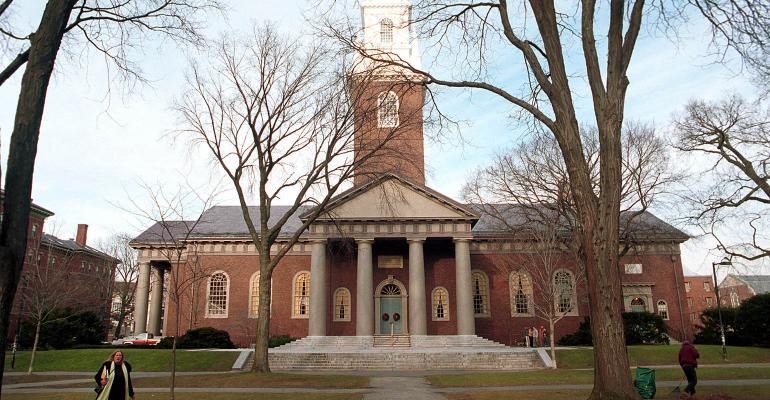(Bloomberg Gadfly) -- It’s that time of year again, time to count with envy all the money made by elite university endowments.
Well actually, no, not this year. Yale’s endowment eked out a mere 3.4 percent return during the fiscal year to June – yet that was enough to make it the big winner among schools that have reported so far. Harvard’s investment portfolio fell 2 percent in fiscal year 2016, while the University of Pennsylvania’s dropped 1.4 percent.
Sure, those endowments have countless resources and connections and clever analysts, but none of that mattered. An investor armed simply with a traditional 60/40 portfolio of U.S. stocks and bonds would have enjoyed a 4.8 percent return over the same period (those are returns for the S&P 500 and the Barclays U.S. Aggregate Bond Index, including dividends), easily beating Yale’s peer-best return.
Granted, it’s only one year, but what happened?
One word: alternatives. Investments that delivered outsized returns to elite endowments for decades – big bets on things like hedge funds and private assets – have let them down in recent years, and 2015/2016 was no exception.
Nearly three-quarters of Yale’s portfolio is in hedge funds and private investments in venture capital, leveraged buyouts, real estate and real assets. Almost 60 percent of Harvard’s portfolio is similarly invested.
Harvard’s alternatives performance last year is indicative: Its hedge fund investments fell 1.2 percent; real assets tumbled 10.2 percent (caused in part by energy’s spectacular collapse). Private equity returned 2.6 percent. This is all part of a worrying trend for alternatives. Hedge funds’ rolling ten-year returns have declined since 1999, while those for private equity have trended down for at least that long.
Given their vast fortunes, elite university endowments will no doubt be just fine. But what about all those smaller institutions – and individuals– who imitate endowments by chasing alternatives? What should they think?
Unhelpfully, there are good reasons to be both bearish and bullish about alternatives. The bear case is widely understood. There’s too much money chasing alternatives: nearly $3 trillion in hedge funds and $2.4 trillion in private equity. That will eventually drag down the performance of any strategy.
Yet there are three reasons why the future could be brighter. First, mean reversion is a powerful force. There's lots of research showing asset prices tend to be cyclical. Alternatives’ recent struggles, in other words, may point to stronger, not weaker returns ahead.
Second, some disappointed investors will pull out of alternatives, which may boost those who stick it out. There’s evidence this is already happening. According to HFR, hedge funds saw net outflows of $23.3 billion in the first two quarters of 2016. Some public pensions in California, New York and New Jersey have cut back or eliminated hedge funds from portfolios.
Third, with U.S. stock valuations at historic highs and interest rates at lows, it’s far from certain that the traditional U.S. 60/40 portfolio will keep beating alternatives. It could do worse.
But here’s the rub. It may not matter what’s ahead for alternatives because even during the best times, there’s a chasm between the returns of elite investors and everyone else. The reason's simple. The best hedge fund and private asset managers have only so much capacity. Elite investors have the resources to find those managers and the connections to join their funds – two advantages that most investors lack.
This isn't trivial. Consider the difference between the best and worst managers. According to Cambridge Associates, the top quartile of private equity investors received an average net internal rate of return of 21 percent from 1986 to 2013 (the longest period for which data is available); the bottom quartile received 6.3 percent.
The spread in hedge funds is even more alarming. According to HFR, the top decile of funds in the HFRI Fund Weighted Composite gained an average of 47.4 percent from 2000 to 2015, while the bottom decile declined by an average of 21.5 percent.
So investors shouldn't kid themselves when mimicking the elite. Why not give that boring portfolio of stocks and bonds a pat on the back for a year well done?
This column does not necessarily reflect the opinion of Bloomberg LP and its owners.
To contact the author of this story: Nir Kaissar in Washington at [email protected] To contact the editor responsible for this story: James Boxell at [email protected]





